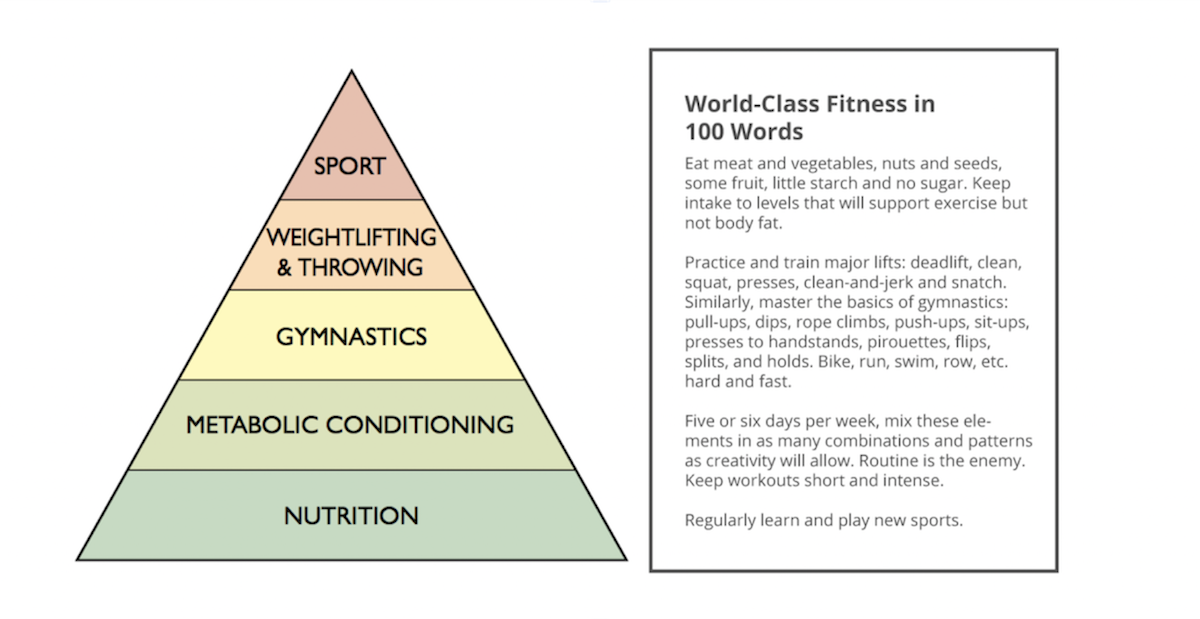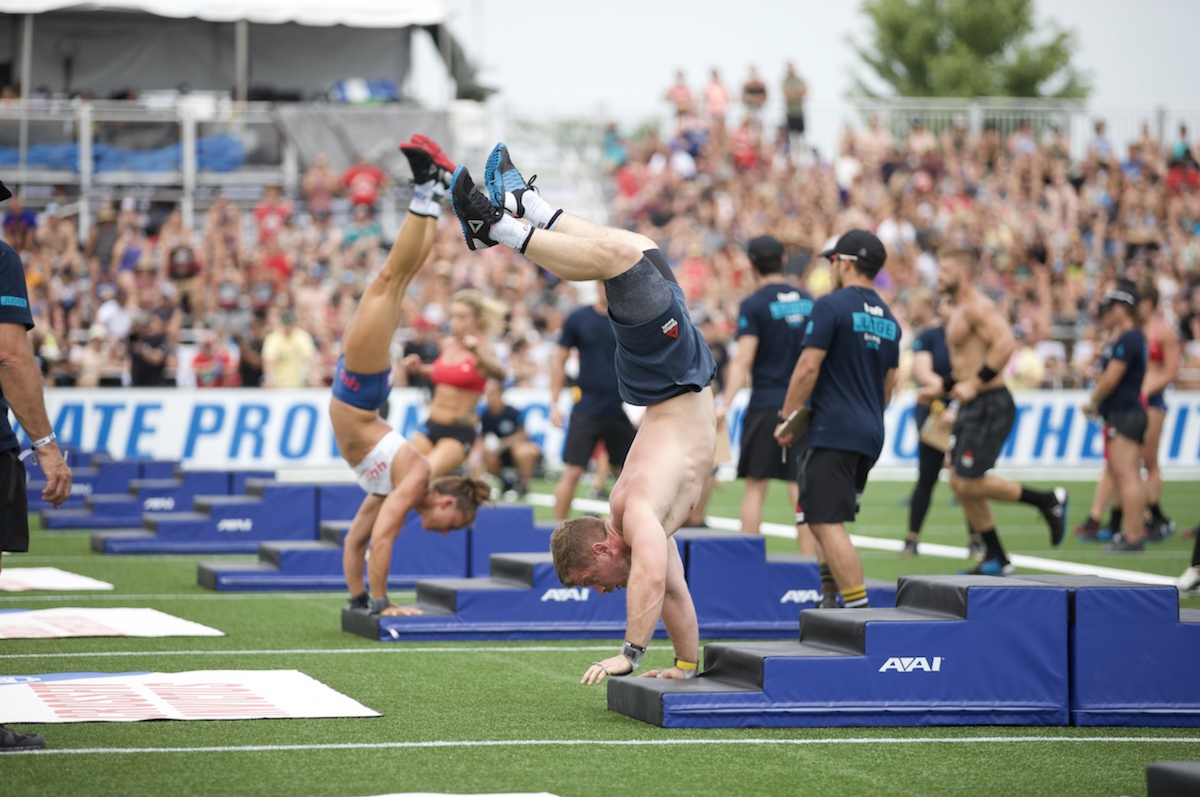Every year since 2007, CrossFit athletes and enthusiasts have watched in anticipation as a field of fit competitors is winnowed down to the final, fittest few. Walking over staircases on their hands and swimming a mile in open water, these athletes seem supernatural. CrossFit presents them, boldly and without equivocation, as the Fittest on Earth.
But are we justified in making that claim? Is Tia-Clair Toomey really fitter than the most decorated gymnast in history, Simone Biles? Is Justin Medeiros fitter than Michael Phelps, who set the most world records in swimming? We might feel more confident in answering if we could see Biles and Phelps take on multiple events outside their specialties, such as a heavy deadlift, a sprint, and a marathon row, but we’re inclined to say “yes.” And that’s because of the very specific parameters of the question.

Dave Castro celebrates Tia-Clair Toomey’s and Mat Fraser's performances at the 2020 Games following Event 12 | Photo by Michael Valentin
How Do We Know What Fitness Is?
In 2002, CrossFit published an article called “What Is Fitness?” It began with what appears to be a simple question — “What is fitness and who is fit?” — but it turns out this was the type of question whose answer, just as you felt you were closing in on it, suddenly evaded you. This is because fitness had no clear definition — until 2002.
Most people know fitness when they see it. It looks something like this, and this, and many of the highlights here. But CrossFit has done what no other fitness program, guru, or exercise scientist has: defined specific parameters by which overall fitness could be defined, evaluated, and tested outside of singular, specialized expressions of fitness. The question of what fitness is and who is fit suddenly became fully measurable and observable.
Read "The Science Behind the Magic of CrossFit"
CrossFit’s definition of fitness is work capacity across broad time and modal domains; a broad, general, and inclusive capacity that prepares you for the unknown and the unknowable. In other words, the fittest athlete is one who will excel while performing many different physical tasks across the greatest range of time frames. These tasks can be quantified. How far did the athlete go? How long did the effort take to complete? How many reps could they achieve? How heavy was the load lifted? If a collection of these metrics are improving across a broad range of activities, the athlete is objectively getting fitter.
The CrossFit methodology was created with the idea that it would prepare a person to accomplish any physical task or combination of tasks randomly chosen out of a hopper.

CrossFit outlined a theoretical hierarchy of development and world-class fitness in 100 words in the 2002 article "What Is Fitness?"
CrossFit isn’t just about being fast and strong. It’s also about cardiovascular/respiratory endurance, stamina, flexibility, power, coordination, agility, balance, and accuracy. These 10 general physical attributes are the basis of one of CrossFit’s models of fitness. A fit person has proficiency across all 10, and the CrossFit Games test that proficiency with all sorts of challenges, including running, lifting, swimming, biking, odd-object work, climbing, basic gymnastics (calisthenics) and more — any combination of endurance work, weightlifting, and gymnastics across short, medium, and long efforts.
The CrossFit athlete is not necessarily faster than a trained sprinter, stronger than a strongman, or more flexible than a gymnast, but their goal is to be as good as they can be across the broadest range of physical tests. In sum, the CrossFit athlete is a jack of all trades, master of none, and fit to face any unknown physical challenge that may come their way. That is why variance is essential in the CrossFit training program.
“CrossFit leans heavily into variance so that you have results and adaptations across a broad range of different things,” GM of Sport Justin Bergh said.

The handstand walk event at the 2018 Games | Photo by Tai Randall
So, for example, the fittest person isn’t the one who can squat 1,000 lb — though that is extremely impressive — but can’t run a mile in under 10 minutes. Nor is it the person who can run a sub-4-minute mile if they can’t squat more than 1.5 times their body weight. Both athletes are impressive in their own right; the former may be the strongest athlete and the latter the fastest, but neither can lay claim to being the fittest, as each athlete is clearly deficient in general capacity outside of their preferred specialty.
But if a person could, for example, manage to stand up 500 lb and run a sub-5-minute mile, well, as Dave Castro noted in “Constructing the CrossFit Games,” according to the CrossFit methodology, that person can be considered pretty fit. The more they can do across a wide range of tasks, the fitter they are.
Why the Winners Are Crowned “The Fittest on Earth”
The winners of the CrossFit Games have demonstrated within a group of their peers with similar and exceptional athletic ability that they are the fittest of them all, which further legitimizes the claim that these athletes are the Fittest on Earth.
“It’s hard to look at a general population and really see the fittest excel,” Bergh said. “In the general population, you might find super strong people or really gifted endurance athletes. But there needs to be a filtering process where the fittest are competing against other fit people. The specialist component of that becomes a little more neutralized.”
To find that group of peers, all athletes start in the worldwide Open and are winnowed down through Quarterfinals and Semifinals to the top 40 men, 40 women, 40 teams, 180 age-group athletes, and 30 adaptive athletes in the world.
Once at the CrossFit Games, these top athletes are tested to their limits with highly skilled movements across all 10 general physical attributes in challenges such as ring muscle-ups, a 42,195-meter row, or even a 600-yard log carry. Often the tests are unknown until moments before the athletes step onto the competition floor, forcing them to adapt to whatever is thrown their way.
As CrossFit Seminar Staff Flowmaster Chuck Carswell explained, “The fittest person — performs statistically best at all the activities that we test over the course of the weekend. … They average somewhere around the 85-90th percentile."
The Mental Game
There’s another element to thriving in the Sport of Fitness that goes under the radar more often than the physical skills, and that’s the mental game. It’s not only about having a strong competition mindset, though that is critical. Just look at how top competitors in 2020 handled the surprise that the 3-mile trail run they had just completed now needed to be repeated in reverse:
In addition to mental fortitude in the face of unknown challenges, CrossFit Games athletes have to think quickly. They have to be smart. The best maintain their composure and mental acuity in the heat of competition and are able to quickly strategize and adjust as necessary to complete the task at hand. Just watch the video below to see the advantage Cole Sager’s quick thinking got him in 2018’s Battleground:
While the other athletes dragged Rescue Randy in the traditional way a first responder might, gripping under the arms and moving backward in a quad-dominant style of running, Sager turned around and ran forward, allowing the larger muscle groups in his posterior chain to propel him. He won the event.
Flexibility, it turns out, may be one of CrossFit’s 10 general physical attributes, but it is also a highly valuable characteristic of the mental game. This has been the case since the Games’ inception. Longtime fans will recall the wheelbarrow event in 2010, during which athletes who were able to think quickly used lighter implements to create platforms they could climb to more efficiently transport their loads.
These kinds of sparkling moments of ingenuity are relatively unique to the CrossFit Games. Olympians are able to push the limits of their sport year after year because they know what the competition will look like. They know what they need to do to move beyond the limits of what seemed impossible last year. CrossFit Games athletes don’t really know what they’re in for when they show up at the Games. And that’s exactly the point. The CrossFit Games put CrossFit’s best athletes on a global stage and pressure-test their physical and mental skills.

Kara Saunders in 2017 | Photo by Thomas Campitelli
The Sport of Fitness
CrossFit is, by design, the most effective way to broaden the range of a person’s physical abilities and increase their work capacity, And the CrossFit Games are the most effective way to test the abilities and work capacities of the best athletes — that is, the Games are the ultimate test of fitness.
That is why the CrossFit Games are called the Sport of Fitness. And that’s why its winners are the Fittest on Earth.
Join the Fittest on Earth in the CrossFit Open
Learn More About the Magic of CrossFit
Related: